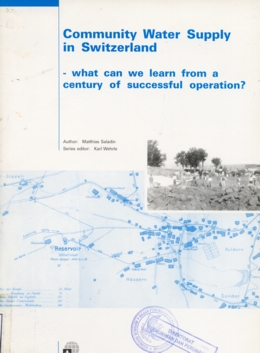Kategori Digilib
Community Water Supply in Switzerland: What can we learn from a century of successful operation?

Matthias Saladin
Switzerland, Swiss Agency for Development and Cooperation (SDC) & SKAT Foundation, 4 series
06 Mei 2008
363.61 SAL c
kumpulan studi kasus, water supply, Switzerland
Perpustakaan Direktorat Perumahan & Permukiman, Bappenas (130-03)
1.248 kali
In the last decade there has been a marked shift towards decentralisation in many developing countries as responsibilities are passed from national administrations to local authorities. In many places this shift to a local approach has left the communities isolated and struggling. Many infrastructures projects are in difficulties because of the lack of organisational support and know-how. In Switzerland, rural communities have developed and managed their own water supply networks for a long time – in some cases over 100 years. There may be lessons that have been learned in Switzerland over this period that could be helpful – if properly adapted – to communities in developing countries as they take responsibility for their own systems.
They management of water supply schemes in Switzerland is very much the responsibility of the individual communities. In many villages these systems were initiated before the end of the nineteenth century and have proved to be appropriate and sustainable over a long periode of time. This publication is not an attempt to promote the ’Swiss system’ as a model for developing countries, but rather seeks to recount some experiences that may be helpful or relevant. Even if the Swiss approach cannot be exported as it is, there still may be some lessons to be learned from more than a century of experience. These shall be pointed out and illustrated in this publication.
The study on hand focuses on villages – settlements of up to 10.000 inhabitants. The history of village water supply systems is quite different from the experiences of the cities, which are beyond the scope of this study. The goal of this publication is to pass on important Swiss experiences to policy- and decision makers and practitioners in other countries, especially in the South. For this purpose, a set of case studies was selected to represent a wide range of different organisational arrangements.
There are two important concepts underlying this study: the ’household-centred approach’ (HCA) and ’balanced development’. (These are described briefly below). The ’household-centred approach’ is a concept that puts the household in the centre of infrastructure projects such as water supply networks or sewers. The idea beneath this concept is taht any decision about water supply or sanitation should attempt to solve the problems as close to the household level as possible. Only if a problem cannot be tackled on one level should a solution at the next level up be considered. In this way more decentralised, bottom-up solutions can be provided, in the hope that they will be more sustainable than the existing ones.
’Balanced development’ is a strategy that takes into account the many different aspects of development projects. The various fields of focus are: social, institutional, economic, and technological aspects, and rules and regulations, knowledge and skills. Any project should be assessed by its implications in all these fields. Additionally, there are environmental issues, which typically are addressed throughout all fields of focus. The present report is structured along the tematic fields of the balanced development strategy.
Contents:
Introduction
Environment and Water
Overall Data for Switzerland
Institutional Aspects
Economic Aspects
Social Aspects
Technological Aspects
Rules and Regulations
Skills and Knowledge
Series of Case Studies:
Rehetobel: A village administration in charge of the water supply network
Wittenbach: Where a club for a few evolved into a co-operative for all
Weinfelden: A municipal administration in charge of the water supply network
Dudingen: Where a company manages the water supply network
